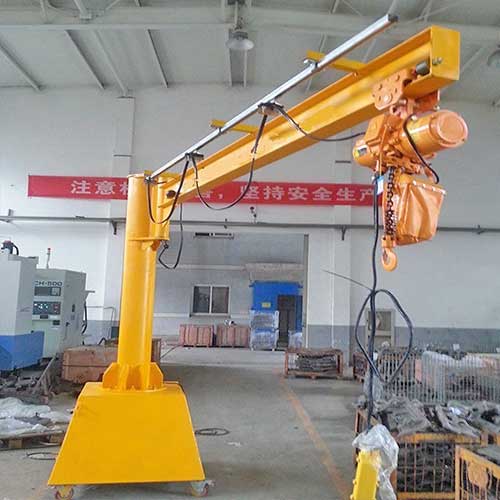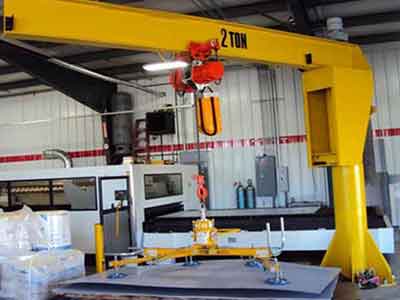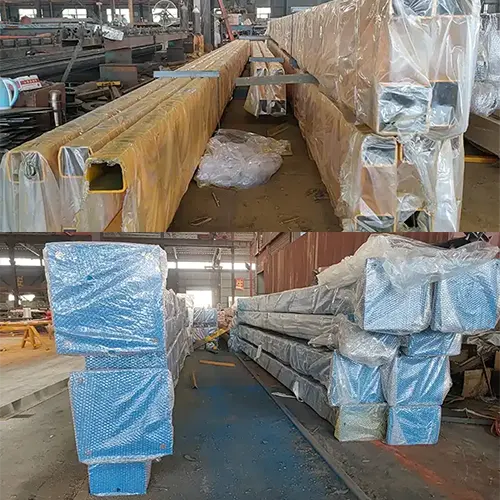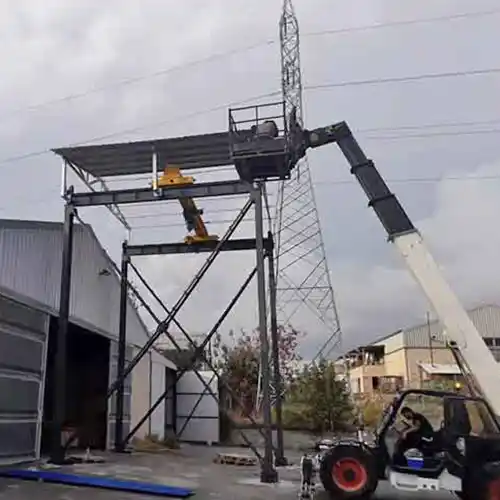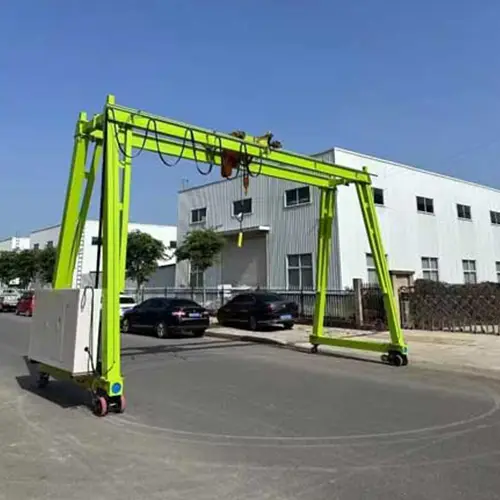Light Duty Jib Crane & Lightweight Jib Crane
Light duty jib crane & lightweight jib crane design for workshop loads handling. Floor jib, wall jib & portable design lightweight jib crane for sale.
Category: Light Crane & Portable Crane
Your Trusted Overhead Travelling Crane Manufacturer & Supplier
Light Duty Jib Crane & Lightweight Jib Crane
Floor Jib, Wall Jib & Portable Design Light Duty Jib Cranes
Lightweight jib cranes for sale at good price, small lightweight jib cranes with lifting capacities ranging from 0.25 ton to 1 ton to 5 ton to 20 ton. Shop lightweight jib cranes, garage lightweight jib cranes, portable lightweight jib cranes, and other types of small lightweight jib cranes are available.
Lightweight jib cranes are a type of adaptable and all-purpose crane used in a wide range of applications. They allow weights to be lifted and moved swiftly and safely, as well as placed accurately and softly, while also increasing efficiency and saving time and energy. A lightweight jib crane is a piece of heavy lifting equipment with a horizontal jib boom, electric chain or wire rope hoist, and other accessories that is affixed to a wall or a column. The majority of lightweight jib cranes have an on/off switch and a stop button to provide safe, quick, and easy boom shifting during material handling activities.
Portable type lightweight jib crane
Portable design light duty jib cranes is a new series of jib cranes with self-supportive jib design, mounted on wheels and rollers for wide material handling with maneuverability and wide adaptability.The portable design light duty jib crane on wheels or on rolling rollers is a small and light duty movable jib crane with small & medium-speed lifting equipment, with the features of unique jib structure design, safe &reliable operation, time & energy saving , high efficiency and flexibility, cost-effective.
Portable type lightweight jib crane parameters:
- Jib crane types: Portable light duty jib crane on wheels, equipped with manual hoist or electric hoists
- Rated load of portable Light Duty Jib crane : 0.08t, 0.125, 0.25t, 0.5t, 1 ton
- Lifting height of portable Light Duty Jib crane : 1.5m, 2m, 3m
- Turning radius of portable Light Duty Jib crane : 2m, 3m
- Rotation angle of portable Light Duty Jib crane : 360°
- Rotary way of portable Light Duty Jib crane : electric or manual
- Lifting speed of portable lightjib crane : 8m/min or 8/0.8m/min

Features of portable design lightweight jib cranes
- The column is made of seamless pipe, while the main beam is made of an I-beam or a KBK beam.
- Manual or motorized rotation is possible.
- Electric wire rope hoists, electric chain hoists, and manual hoists are all options for the hoist.
- Unique structure that is secure and dependable, as well as efficient and versatile.
- Can be tailored to meet the needs of the client.
- Installation is simple.

360 degree rotating lightweight jib crane
500kg to 1 ton portable lightweight jib crane and customized lightweight jib crane are available.

Portable lightweight jib crane
500kg to 1 ton floor mounted portable lightweight jib crane and customized lightweight jib crane are available.

Portable light duty jib crane
500kg to 1 ton floor mounteed portable lightweight jib crane and customized lightweight jib crane are available.
Floor design light duty jib crane
This floor-mounted or Floor type lightweight jib crane usually uses an electric wire rope or electric chain hoist, which is made up of a stationary column, rotating arm, rotation driving mechanism, and electric hoist.
Anchor bolts secure the column to the concrete foundation. The motor rotates the cantilever by operating the driving mechanism. On the jib beam, there is an electric hoist.
A Light&Middle work class floor mounted lightweight jib crane can load 0.25t, 0.5t, 1t, 2t, 3t, 5t, 8t, 10t, and 16t. You can select multiple weight capacities and rotation angles, such as 180°, 270°, and 360°, depending on your specific working environment
BZ Floor type lightweight jib crane parameters:
- Lifting Capacity of Floor Light Duty Jib: 0.5t-20t
- Valid Radiusof Floor Light Duty Jib: 3-15m
- Lifting Height of Floor Light Duty Jib: 3-8m
- Slewing Angle of Floor Light Duty Jib: 0-360°
- Lifting Speed of Floor Light Duty Jib: 0.33-8m/min
- travelling Speed of Floor Light Duty Jib: 10/min
- Slewing Speed of Floor Light Duty Jib: 0.4-1r/min
- Work Duty of Floor Light Duty Jib: A3, A4

Features of floor design light duty jib cranes
- The column is made of seamless pipe, while the main beam is made of an I-beam or a KBK beam.
- Manual or motorized rotation is possible.
- Electric wire rope hoists, electric chain hoists, and manual hoists are all options for the hoist.
- Unique structure that is secure and dependable, as well as efficient and versatile.
- Can be tailored to meet the needs of the client.
- Installation is simple.

Free standing lightweight jib crane
500kg to 20 ton free standing lightweight jib crane and customized lightweight jib crane are available.
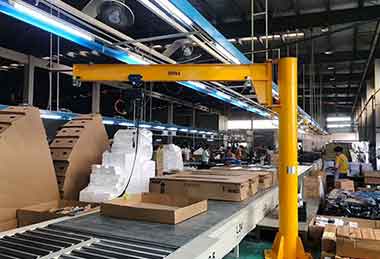
Floor mounted lightweight jib crane
500kg to 20 ton floor mounted lightweight jib crane and customized lightweight jib crane are available.

360 degree roating lightweight jib crane
500kg to 20 ton floor mounteed lightweight jib crane and customized lightweight jib crane are available.
BX wall-mounted design lightweight jib crane
It's a light wall mounted lightweight jib crane that can be mounted to a wall or pilaster, or it can operate along an elevated track on a wall or other supporting structure, and it doesn't have to be in the plant. Plant space is used more efficiently.
Check whether the product and technical documentation are missing from the packing list before installing the wall-mounted cantilever crane; check whether the cantilever beam is bent or twisted, the shaft is corroded, or the crane was bumped during transit. Additionally, rotating parts such as shafts and bearings should be cleaned and greased every six months.
BX wall-mounted lightweight jib crane parameters:
- Lifting Capacity of Wall Light Duty Jib: 0.5-10t
- Valid Radius of Wall Light Duty Jib: 3-8m
- Lifting Height of Wall Light Duty Jib: 6-30m
- Slewing Angle of Wall Light Duty Jib: 0-180°
- Lifting Speed of Wall Light Duty Jib: 0.7-8m/min
- travelling Speed of Wall Light Duty Jib: 10/min
- Slewing Speed of Wall Light Duty Jib: 0.4-1r/min
- Work Duty of Wall Light Duty Jib: A3, A4
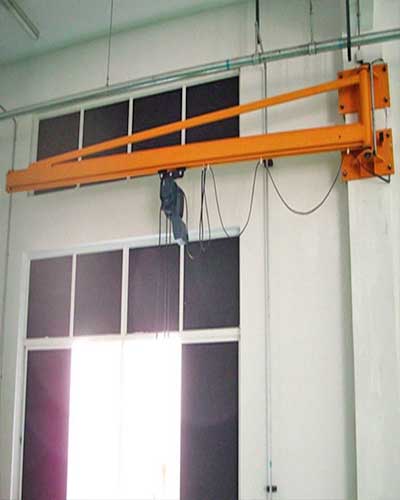
If you're installing a cantilever, please do so in the order listed below. 1) Drill holes in the workshop column in the locations shown on the drawing; 2) Using a crane, lift the cantilever, secure it with fixing bolts to the upper and lower support plates, measure the upper deflection with a level, and tighten the nut on the rotating shaft clockwise. 3) On the cantilever beam track, install an electric hoist, a walking trolley, and a slewing mechanism.. 4) Attach a C-shaped track to the cantilever beam's top. In the C-shaped track, there is a self-made sliding trolley that should be on the same side as the electrical control box. 5) Power cords of suitable length must be used to connect and install all electrical appliances on the cantilever beam. A binding wire is used to tie and fix the C-type track block and the cable, respectively.
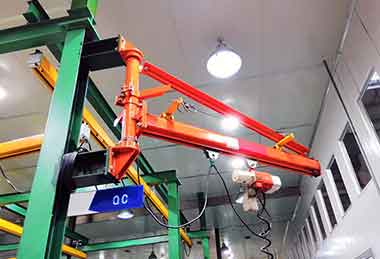
BX wall-mounted lightweight jib crane
0.5 ton t0 10 ton wall mounted lightweight jib crane and customized wall mounted lightweight jib crane for sale.
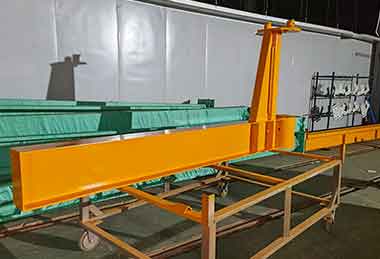
BX wall lightweight jib crane
0.5 ton t0 10 ton wall lightweight jib crane and customized wall mounted lightweight jib crane for sale.

180 degree Slewing wall-mounted lightweight jib crane
0.5 ton t0 10 ton 180 degree rotating lightweight jib crane and customized wall mounted lightweight jib crane for sale.
Features of wall mounted design lightweight jib crane
- A wall-mounted cantilever crane is utilized near the wall in workshops or warehouses with a broad span and plenty of headroom.
- Lifting light things is possible with this tool.
- It has a one-of-a-kind structure that is both safe and dependable.
- Economical and productive.
- Make the most of your time.
- Operation that is both flexible and convenient.
- A wide range of applications is available.
- Suitable for short-distance lifting activities; cost-effective and long-lasting.
Wall-travelling lightweight jib crane
The wall travelling type lightweight jib crane is a type of cost-effective lightweight jib crane that travels along a rail mounted on a wall or other supporting structure to maximize working space for item lifting and transportation. Because manually lifting and moving heavy objects is difficult and time consuming, the wall travelling crane can provide lateral movement of heavy materials while the hoisting equipment working with the crane can lift the materials in a vertical direction, making the best use of the working space and saving much manpower.
BB wall-travelling lightweight jib crane parameters:
- Lifting Capacity of Wall Light Duty Jib: 0.5-16t
- Valid Radius of Wall Light Duty Jib: 5-12.5m
- Lifting Height of Wall Light Duty Jib: 6-30m
- Lifting Speed of Wall Light Duty Jib: 0.35-8m/min
- Hoist travelling Speed of Wall Light Duty Jib: 10/min
- Crane travelling Speed of Wall Light Duty Jib: 20m/min
- Work Duty of Wall Light Duty Jib: A3, A4
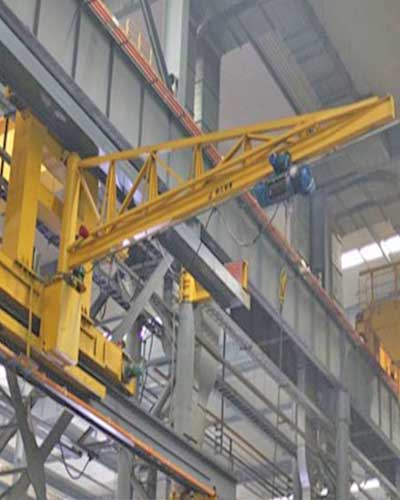
- The crane's lifting capacity ranges from 0.5 to 10 tons, and it may be adapted to meet specific needs. Its working duty is A3.
- Wall travelling lightweight jib cranes can be employed in a variety of locations, including machine manufacture and assembly workshops, maintenance factories, warehouses, and other outdoor working environments.
- It can also be used as a supplement to an overhead crane system for material handling, and numerous wall travelling lightweight jib cranes can travel along the same track and function in tandem as needed without interfering with each other or overhead cranes, resulting in increased labor efficiency and production.
The lifting mechanism for this type of travelling lightweight jib crane is an electric wire rope hoist or a chain hoist, which should be chosen based on the material lifting requirements.
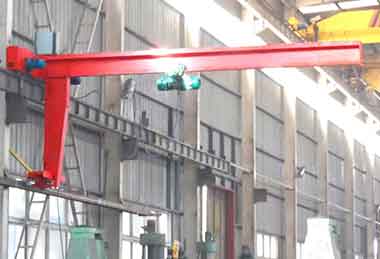
Wall travelling lightweight jib crane
0.5 ton -16 ton wall travelling lightweight jib crane and customized lightweight jib crane for sale.

500kg -16 ton wall travelling lightweight jib crane
0.5 ton -16 ton wall travelling lightweight jib crane and customized lightweight jib crane for sale.
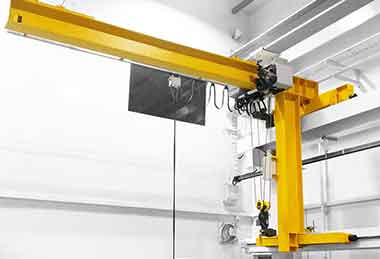
Wall travelling lightweight jib crane with simple & light crane
0.5 ton -16 ton wall travelling lightweight jib crane and customized lightweight jib crane for sale.
Why Choose lightweight jib crane
- Lightweight jib cranes can be utilized in both indoor and outdoor settings, such as garages, warehouses, maintenance shops, manufacturing and assembly plants, construction sites, ports and docks, and so forth.
- We can design and manufacture a variety of lightweight jib cranes, including freestanding lightweight jib cranes, mast type lightweight jib cranes, Floor mounted lightweight jib cranes, floor mounted lightweight jib cranes, wall mounted jibs, wall moving jibs, 360°lightweight jib cranes, mobile lightweight jib cranes, compact lightweight jib cranes, and heavy duty lightweight jib cranes, among others. You may receive the greatest jib from us no matter what kind of jib you require.
- Our basic lightweight jib crane is a better option for saving money and energy while increasing productivity;
- When you need to move or relocate them, our lightweight jib cranes have a suitable design, small structure, and light weight; they are versatile and easy to install and disassemble.
- This type of lightweight jib crane is compact and takes up little room;
- The jibs are constructed in strict conformity with lifting requirements, ensuring the quality and safety of the cranes.
- Custom options are available for customers to meet their specific needs;
- All of our lightweight jib cranes are available at extremely low, competitive pricing.
The basic lightweight jib crane is the ideal choice for lifting and moving operations in tiny and narrow spaces due to its compact size. lightweight jib cranes are often used in warehouses, production and assembly lines, ports, docks, maintenance workshops, workstations, and other places where big goods must be lifted, moved, and lowered.
We can offer you with a customized wall-mounted lightweight jib crane, 360 degree lightweight jib crane, articulating lightweight jib crane, fixed lightweight jib crane, column mounted lightweight jib crane, and so on, thanks to our extensive experience in designing and manufacturing various types of lightweight jib cranes. Regardless of the type of lightweight jib crane you require or the application for which it will be used, you can rely on one from our company. We guarantee that our clients will receive competent and high-quality lightweight jib cranes at a reasonable price. If you have any questions about the lightweight jib crane, please contact us and we will respond as quickly as possible. For additional information on our basic lightweight jib crane for sale, please contact us.
Your Trusted Light Crane Manufacturer & Supplier
A Comprehensive Guide to Light Duty Jib Cranes
Finding the Perfect Fit for Your Industry Needs
Light duty jib cranes stand as versatile lifting solutions known for their maneuverability and efficiency. They consist of a horizontal jib or boom that's attached to a vertical mast or pillar. These cranes excel in handling lighter loads within specific work areas, offering precise and controlled movement for a variety of industries.
Definition and Functionality
Light duty jib cranes are designed to facilitate lifting operations within confined spaces or designated work zones. Their functionality involves a rotating boom that allows for horizontal movement, offering flexibility in load positioning and handling.
Importance in Various Industries
The significance of light duty jib cranes resonates across multiple industries. From manufacturing plants requiring precise assembly processes to warehouses necessitating efficient material handling, these cranes serve as indispensable tools. Industries such as automotive, construction, logistics, and even healthcare benefit from their ability to streamline operations and improve productivity.
Overview of Light Duty Jib Cranes
Types of Light Duty Jib Cranes
- Free Standing Jib Cranes -These cranes are self-supporting and do not require attachment to a building structure. They offer versatility and ease of movement, ideal for environments where frequent relocation is necessary.
- Wall Mounted Jib Cranes -Wall-mounted jib cranes are fixed to a wall or vertical support structure, providing a space-saving lifting solution and leaving the floor area unobstructed.
- Articulating Jib Cranes -Articulating jib cranes feature movable arms, offering extended reach and flexibility. They are suitable for confined spaces or areas where obstacles need to be maneuvered around.
- Light Portable Jib Cranes -These cranes are designed for maximum portability and ease of assembly. They are suitable for temporary lifting needs or areas without permanent crane installations.
The load capacity and reach of a light duty jib crane are critical considerations. Understanding the weight of the loads to be lifted and the required reach helps in selecting the appropriate crane model to meet specific operational needs.
Identifying Industrial Needs
Assessing Specific Industry Requirements
Understanding the unique demands of different industries is paramount when considering the adoption of a light duty jib crane. Each industry has its specific workflow, load types, and operational intricacies that necessitate tailored lifting solutions. For instance:
- Manufacturing sectors might require precision in material handling and assembly processes.
- Warehouses and logistics facilities often need efficient load movement and storage solutions.
- Construction sites may require versatile cranes adaptable to various on-site tasks.
Determining Application Areas
Identifying where the crane will be utilized within the industrial setting is crucial. Whether it's on a production line, at a loading dock, within a workshop, or in a specific department, understanding the application area assists in selecting the appropriate type and configuration of the jib crane.
Load Types and Frequency of Use
Assessing the types of loads to be lifted and their frequency is vital. Whether it involves handling raw materials, finished products, machinery, or components, understanding the weight, size, and frequency of lifting operations helps in choosing the right crane with the appropriate load capacity and reach.
Space Constraints and Operational Environment
Space availability and operational environment play significant roles in crane selection. Areas with limited space might favor wall-mounted or articulating jib cranes to optimize floor space. Additionally, considering the operational environment—such as temperature variations, exposure to chemicals or dust—helps in determining the material and construction specifications required for the crane.
Understanding these aspects enables buyers to align the selection of a light duty jib crane with the specific needs and constraints of their industry, ensuring optimal performance and efficiency.
Factors Influencing Purchase Decision
Load Capacity and Span Requirements
Determining the load capacity a crane needs to handle is fundamental. Assessing the heaviest loads and their variations ensures the chosen crane can manage the required weight. Additionally, considering the span or distance the crane needs to cover aids in selecting the appropriate reach and jib length.
Hoist and Trolley Configurations
Understanding the hoist and trolley configurations available is crucial. Different hoist types (electric chain hoists, wire rope hoists, etc.) and trolley arrangements (manual, powered) offer various lifting capabilities and operational efficiencies. Selecting the right combination enhances productivity and ease of use.
Material and Construction Specifications
Choosing the appropriate materials and construction specifications ensures durability and longevity. Factors such as exposure to environmental elements, corrosive substances, or heavy usage impact the choice of materials (steel, aluminum, etc.) and construction methods.
Customization Features: Height Adjustability, Boom Length, Rotation Angle, etc.
Customization plays a pivotal role in aligning the crane with specific operational needs. Height adjustability, boom length variations, rotation angles, and other customization features enable the crane to adapt precisely to the workspace constraints and lifting requirements.
Safety Features and Compliance with Standards
Prioritizing safety is paramount when selecting a light duty jib crane. Ensuring compliance with industry safety standards and regulations is non-negotiable. Additionally, integrated safety features such as overload protection systems, emergency stop buttons, and warning alarms contribute to a safer work environment.
Carefully considering these factors assists buyers in making informed decisions when purchasing a light duty jib crane that perfectly aligns with their industry needs and operational requirements.
Sourcing and Choosing the Right Light Crane
Researching Reputable Manufacturers and Suppliers
Begin the process by researching and identifying reputable manufacturers and suppliers of light duty jib cranes. Look for companies with a proven track record, positive customer reviews, and a history of delivering reliable and high-quality crane solutions. Consider their experience, certifications, and adherence to industry standards.
Requesting Quotes and Evaluating Costs
Once potential manufacturers and suppliers are identified, request quotes for the desired light duty jib crane configurations. Compare the costs and analyze the provided quotes in detail, considering factors such as initial investment, installation costs, and any additional expenses for customization or special requirements.
Reviewing Customization Options Offered by Suppliers
Evaluate the customization options offered by the suppliers. Assess whether they can tailor the crane specifications to align with the specific industrial needs identified earlier. Customization options might include adjustable boom lengths, special attachments, varying rotation angles, or additional safety features.
Considering After-Sales Support, Warranty, and Maintenance Services
Apart from the crane itself, consider the after-sales support, warranty, and maintenance services provided by the manufacturer or supplier. Assess the warranty period offered, available maintenance packages, and their responsiveness to service calls or technical support. Reliable after-sales support ensures continued smooth operation and addresses any potential issues promptly.
Carefully considering these steps assists buyers in sourcing the right light duty jib crane and supplier that not only meets their immediate requirements but also provides long-term reliability and support.
Customization of Light Duty Jib Cranes
Knowing Unique Customization Needs
Recognizing the specific and unique requirements of each industry or workspace is essential before delving into customization. Identify the challenges, limitations, and specific demands that a standard crane may not adequately address.
Tailoring Crane Specifications to Industrial Requirements
Customization offers the opportunity to align the crane specifications precisely with the industrial needs. Whether it's modifying the crane's height, boom length, or adjusting rotation angles, tailoring the specifications ensures optimal performance within the designated work area.
Examples of Specialized Customization: Load Sensors, Remote Controls, etc.
Explore specialized customization options that can significantly enhance the crane's functionality. This may include incorporating load sensors for precise weight measurement, integrating remote control systems for ease of operation, or implementing specialized attachments to suit unique lifting requirements.
Consulting with Manufacturers for Tailored Solutions
Engage in discussions with crane manufacturers to explore tailored solutions. Manufacturers with expertise in customization can offer valuable insights and recommendations to meet specific industrial requirements. Collaborating closely with manufacturers ensures that the resulting crane design perfectly suits the intended application.
Customization plays a pivotal role in maximizing the efficiency and adaptability of light duty jib cranes. By tailoring the crane specifications to address specific challenges and operational needs, industries can optimize their workflow and improve productivity.
Installation, Maintenance, and Safety Guidelines
Preparing for Crane Installation
Before installation, ensure a thorough assessment of the installation area. This involves verifying the structural integrity of the installation site, ensuring adequate clearance, and confirming that the surface can support the crane's weight. Follow manufacturer guidelines and enlist certified professionals for safe and precise installation.
Regular Maintenance Practices for Optimal Performance
Implementing a proactive maintenance schedule is crucial for ensuring the crane's longevity and optimal performance. Regularly inspect components, lubricate moving parts, and address any signs of wear or damage promptly. Adhering to manufacturer-recommended maintenance procedures helps in preventing breakdowns and ensures safe operation.
Safety Protocols and Best Practices for Operation
Establish comprehensive safety protocols for operating the crane. This includes ensuring that operators are trained and certified to handle the crane, following proper load handling procedures, and maintaining clear communication during operations. Emphasize adherence to safety guidelines to mitigate potential risks and accidents.
Training Requirements for Operators
Conduct thorough training sessions for crane operators. Training should encompass crane operation, safety procedures, emergency protocols, and maintenance awareness. Ensuring that operators are well-versed in these aspects not only enhances safety but also contributes to efficient and effective crane utilization.
Prioritizing installation adherence, regular maintenance, strict safety protocols, and comprehensive training is paramount to ensure safe and efficient operation of the light duty jib crane within an industrial setting.
Conclusion
In this comprehensive guide, we explored the intricate world of light duty jib cranes and their significance across diverse industries. Key considerations included understanding the components, types, and customization options available. We delved into factors influencing the purchase decision and highlighted the importance of identifying specific industrial needs, considering load capacities, and assessing workspace constraints.
Emphasizing the Importance of Choosing the Right Crane
Selecting the appropriate light duty jib crane is pivotal to optimize industrial operations. Each aspect, from load capacity to safety features, must align with the industry's unique requirements and operational environment. Making an informed decision ensures efficiency, productivity, and safety in the workplace.
Encouraging Collaboration with Manufacturers for Customized Solutions
The importance of collaboration with crane manufacturers cannot be overstated. Manufacturers proficient in customization can provide tailored solutions that precisely meet industrial needs. Engaging in discussions and leveraging their expertise results in a crane design that maximizes efficiency and addresses specific challenges.
The comprehensive guide aimed to assist buyers seeking customized light duty jib cranes in making informed decisions. We hope this guide serves as a valuable resource, aiding in the selection of the right crane to enhance operational efficiency and productivity.
For further exploration and assistance in acquiring the perfect light duty jib crane, we encourage reaching out to reputable manufacturers, exploring additional resources, and consulting with experts in the field.
Related Products

Latest project
150 Ton Overhead Crane Installation Feedback – Paraguay Case
QDX 150 ton overhead crane in action in Paraguay. Installation photos, video, and client feedback show performance, safety, and heavy-lifting efficiency.
Free consultation to Confirm Parameters & Specifications and Get
Latest Crane Price & Crane Rate.
- Types of overhead cranes : _______?
- Optional: Overhead travelling crane, goliath gantry crane,Slewing jib crane, Single girder or double girder crane,small portable crane or kbk crane, etc.
- Capacity of overhead crane: _______?
- Optional: 0.25ton, 0.5 ton, 1 ton, 2 ton, 3ton, 5 ton, 10 ton,15ton, 20ton, 25 ton, 30ton,35ton, up to 550ton, etc.
- Crane span & lifting height : _______?
- Crane travelling length : _____?
- Control of overhead crane:_______?
- Optional: pendant/ remote/cabin control
- Voltage supply of overhead crane:_____?
- Eg,: 380V50/60HZ,3Phase or others,etc.
- Application/usage of crane:_______?
- Eg,: Steel mill, ,injection mold, cement,stone, concrete,granite, general manufacturing, etc.
Just leave a message via the contact form and our hoist and crane engineer will contact you with in 24working hours.
Get In Touch
